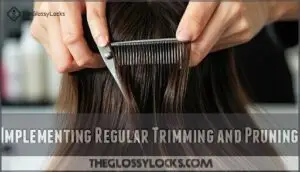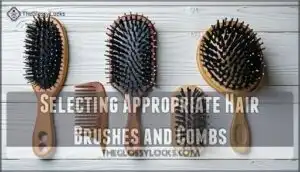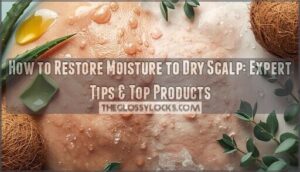This site is supported by our readers. We may earn a commission, at no cost to you, if you purchase through links.
 Learning how to manage thick coarse hair starts with embracing moisture as your best friend.
Learning how to manage thick coarse hair starts with embracing moisture as your best friend.
You’ll want to use sulfate-free shampoos and rich conditioners that don’t strip your hair’s natural oils.
Deep conditioning treatments once a week work wonders, while leave-in conditioners become your daily allies.
When styling, work with damp hair and use wide-tooth combs to prevent breakage.
Heat protectants are non-negotiable before any styling tools touch your strands.
Think of your hair like a garden – it needs consistent care, patience, and the right nutrients to flourish.
The secret lies in understanding your hair’s unique personality and specific needs, which is crucial for effective hair management and requires a deep understanding of what works best for your hair.
Table Of Contents
Key Takeaways
- Prioritize moisture above all else – Use sulfate-free shampoos and rich conditioners to prevent stripping your hair’s natural oils, and incorporate weekly deep conditioning treatments with leave-in conditioners as daily essentials.
- Work with your hair’s natural texture, not against it – Apply products to damp hair using wide-tooth combs to prevent breakage, and always use heat protectants before styling tools to maintain your hair’s integrity.
- Establish a consistent care routine tailored to your specific hair type – Assess your hair’s texture, porosity, and elasticity to choose products that work with your unique characteristics, and trim every 6-8 weeks to prevent split ends.
- Support healthy growth from the inside out – Maintain proper hydration with 8-10 glasses of water daily, eat iron-rich foods and omega-3 fatty acids, and manage stress through regular exercise to boost scalp circulation and hormone balance.
Thick Coarse Hair Types
Understanding your specific hair type forms the foundation for effective thick coarse hair management.
You’ll need to assess your hair’s texture, porosity, and elasticity to choose the right products and techniques that work with your hair’s natural characteristics, which is crucial for effective management.
Identifying Hair Texture and Porosity
Understanding your hair’s unique characteristics starts with evaluating texture types and porosity levels.
Hold a single strand between your fingers—thick hair feels substantial, while coarse hair has a rough surface.
Test porosity by dropping clean strands in water; low porosity floats, high porosity sinks quickly.
Examine strand diameter, density assessment, and curl patterns to master effective hair management and personalized hair care routines, which involves understanding porosity levels.
Determining Hair Elasticity and Strength
Two simple tests reveal your thick coarse hair’s true nature.
For elasticity testing, stretch a wet strand—healthy hair extends 30% before snapping back.
Check strand thickness by rolling it between your fingers; coarse hair feels substantial and wiry.
These strength factors directly impact hair manageability and breakage prevention.
Understanding porosity impact helps you choose products that won’t weigh down your hair texture.
Understanding Hair Growth Patterns and Cycles
Your thick coarse hair follows three distinct growth phases: anagen (active growth), catagen (transitional), and telogen (resting/shedding).
Genetic factors determine your cycle length, typically lasting 2-7 years.
Follicle activity varies across your scalp, creating natural shedding rates of 50-100 strands daily.
Understanding these patterns helps optimize hair health through targeted scalp health tips and proper hair maintenance routines.
Managing Thick Coarse Hair
Managing thick coarse hair doesn’t have to feel like wrestling a wild beast. Think of it as learning to work with your hair’s natural personality rather than against it. The key to effective thick hair management starts with understanding what your strands actually need.
Treat your thick coarse hair like a dance partner—learn its rhythm instead of fighting its natural moves.
Your coarse hair care routine should prioritize hydration importance above all else. Thick, coarse strands are naturally drier and more prone to frizz, so moisture becomes your best friend. However, watch out for product buildup – heavy products can weigh down your hair and make it look greasy at the roots while leaving ends parched.
Don’t overlook scalp health in your quest for gorgeous locks. A healthy scalp produces the natural oils your thick hair craves. Consider overnight protection with silk pillowcases or bonnets to prevent friction damage. Understanding your hair’s texture and porosity helps tailor your hydration methods. When frizz control methods aren’t cutting it, professional treatments can provide the intensive care needed for smoothing coarse hair effectively.
Hair Care Routine Essentials
You’ll need a consistent routine with specific products designed for your hair’s unique needs to keep thick coarse hair healthy and manageable.
The right combination of cleansing, conditioning, and protective treatments can transform your hair from unruly to beautifully controlled.
Choosing Suitable Shampoos and Conditioners
You’ll find success with the right shampoo and conditioner combo for your thick, coarse strands.
Best shampoos for thick hair require specific formulations that work with your unique texture.
Here are five essential considerations for hair care products:
- Sulfate-free options prevent excessive drying while maintaining scalp health
- Hydrating ingredients like argan oil provide vital hair hydration tips
- Protein balance strengthens without weighing down your hair
- Moisturizing hair products with glycerin boost moisture retention
- Clarifying shampoos remove buildup while protecting your hair’s integrity
To enhance hair thickness, consider shampoos that stimulate hair follicles.
Using Hair Masks and Deep Conditioning Treatments
Hair masks reveal your thick coarse hair’s potential through targeted deep conditioning routines.
Apply protein-rich treatments from mid-length to ends on damp hair, focusing on damaged areas. Weekly hair masking with hydrating formulas transforms unruly strands into manageable locks.
For enhanced shine, consider masks with natural oils to smooth the hair cuticle and reduce frizz, as they offer restoring shine benefits.
The best conditioners for coarse hair contain natural oils and moisturizing agents that penetrate deeply.
| Mask Type | Key Ingredients | Application Frequency |
|---|---|---|
| Hydrating Masks | Natural oils, moisturizing agents | 1-2 times weekly |
| Protein Treatments | Keratin, amino acids | Weekly for damaged hair |
| Deep Conditioners | Vitamins, rich hydrating formulas | 2-3 times weekly |
| DIY Recipes | Honey, avocado, coconut oil | As needed basis |
Implementing Regular Trimming and Pruning
Regular trimming keeps your thick coarse hair healthy and manageable.
You’ll want to schedule cuts every 6-8 weeks to prevent split ends from traveling up the hair shaft.
To further enhance your routine, consider incorporating protective styling techniques to minimize damage.
- Trim Frequency: Book appointments every 6-8 weeks for ideal hair health
- Split End Removal: Ask your stylist to focus on damaged ends during each visit
- Layering Methods: Request long layers to reduce bulk while maintaining length
- Shape Maintenance: Keep your style’s structure intact with regular pruning techniques
Protecting Hair From Heat and Sun Damage
While UV hair damage affects everyone, thick coarse hair faces unique challenges from heat styling tools and sun exposure.
Apply protective hair products before using any heat styling protection devices, setting temperatures below 350°F.
Don’t forget scalp sunburn prevention with UV-blocking hair treatment products.
Proper hydration importance can’t be overstated—deep conditioning maintains your hair’s natural barrier against environmental damage.
Styling Thick Coarse Hair
You can transform your thick coarse hair into manageable, stylish looks with the right techniques and tools.
Proper styling methods will help you achieve professional results while maintaining your hair’s natural strength and texture, using the right techniques to make your hair more manageable.
Selecting Appropriate Hair Brushes and Combs
Your bristle type makes all the difference. Choose nylon bristles for effective hair detangling, while boar bristles distribute natural oils beautifully.
Wide-tooth combs prevent breakage during hair combing sessions. Brush shape matters too – paddle brushes work perfectly for thick textures.
Handle ergonomics reduce hand fatigue during longer hair brushing routines. Regular cleaning brushes maintains their hair care brushing effectiveness.
Consider a brush for thick hair to effectively manage and style coarser textures, using the right brushing routines.
Using Styling Products for Manageability
After selecting the right tools, you’ll need quality hair products for ideal hair manageability.
Strategic product layering transforms unruly strands into manageable locks. Apply heat protection before styling, then add hold strength products for lasting hair control.
Focus on application techniques—distribute evenly from mid-length to ends. Choose product ingredients like oils and silicones for effective hair solutions, ensuring lasting hair control.
Mastering Braiding and Updo Techniques
Three protective hairstyles work wonders for thick coarse hair: French braids, Dutch braids, and twisted updos. These braiding styles create secure hold while enhancing your hair’s natural texture.
Start with damp hair and quality hair control products for style longevity. For securing these styles, consider options for suitable clip types.
Master these updo variations by practicing simple techniques first, then advancing to complex designs that showcase your hair’s beautiful volume.
Enhancing Hair Texture With Accessories
Accessories transform thick coarse hair into stunning masterpieces.
Headband styles create instant polish while scarf tying adds bohemian flair.
Strategic clip placement tames flyaways and sections unruly strands.
Jewelry integration with hair pins elevates simple looks.
Hat options protect while styling – wide-brim fedoras complement volume beautifully.
These hair accessories offer endless possibilities for hair texture improvement, giving you complete control over your styling game, with bohemian flair.
Maintaining Healthy Hair Growth
You can’t expect your thick coarse hair to grow strong and healthy without supporting it from the inside out through proper nutrition and lifestyle habits.
The foundation for managing your hair successfully starts with understanding how your daily choices directly impact your hair’s growth cycle and overall condition.
Eating a Balanced Diet for Hair Health
Nourish your thick coarse hair from within by fueling up with the right nutrients.
Your hair’s strength depends on adequate protein intake and proper mineral absorption to prevent vitamin deficiencies that damage texture. Omega-3s strengthen strands and increase hair density, contributing to overall hair health.
Strong, healthy hair starts with what you put on your plate—fuel your follicles from the inside out.
- Iron-rich foods boost hair growth stimulation and prevent breakage
- Omega-3 fatty acids enhance hair nourishment and shine naturally
- Biotin supplements support hair care health and thickness improvement
- Zinc sources promote hair texture improvement and scalp wellness
- Gut health foods maximize hair care nourishment through better absorption
Staying Hydrated for Optimal Hair Growth
Proper hydration directly impacts your ability to manage thick coarse hair effectively.
Water intake should reach eight glasses daily to support hair moisture from within.
Electrolyte balance maintains scalp hydration, while hydrating foods like watermelon and cucumber boost hair nourishment.
Consider humectant use in products to lock moisture into strands, promoting ideal hair growth stimulation.
| Hydration Method | Daily Recommendation |
|---|---|
| Water Intake | 8-10 glasses |
| Hydrating Foods | 2-3 servings |
| Scalp Massage | 5 minutes |
| Humectant Products | Morning/evening |
| Room Humidity | 40-50% |
The daily recommendation for hydration methods is outlined in the table above, providing a clear guide for managing thick coarse hair and promoting hair nourishment.
Reducing Stress for Hair Well-being
Chronic tension creates a domino effect on your scalp, triggering stress hormones that disrupt hair growth cycles.
When you manage thick coarse hair effectively, prioritizing mental health becomes essential. Poor sleep quality increases scalp tension, making strands more brittle.
Embrace holistic wellness through meditation, deep breathing, or yoga. These hair care management strategies reduce cortisol levels, supporting stronger, healthier growth patterns naturally, promoting hair growth.
Getting Regular Exercise for Hair Benefits
Regular exercise boosts scalp bloodflow, enhancing nutrient delivery to your thick coarse hair follicles.
Your hair care routine benefits tremendously from consistent physical activity, which promotes stress reduction and hormone balance essential for healthy hair growth.
Here’s how exercise transforms your hair care management:
- Improves circulation for stronger hair volume
- Reduces cortisol levels that damage follicles
- Balances hormones supporting healthy growth cycles
- Increases oxygen flow to scalp tissues
- Enhances overall hair tips effectiveness
Exercise has a profound impact on hair health, and by incorporating physical activity into your daily routine, you can experience healthy hair growth and improved overall well-being, thanks to consistent physical activity and better hormone balance.
Frequently Asked Questions (FAQs)
Can thick coarse hair be permanently straightened?
Yes, you can permanently straighten thick coarse hair through chemical relaxers or Japanese thermal reconditioning.
However, these treatments damage hair structure and require professional application plus ongoing maintenance to prevent breakage and maintain results, which can be a significant consideration for permanent straightening.
How often should thick coarse hair be washed?
Like Rapunzel’s locks, your thick coarse hair doesn’t need daily washing.
You’ll want to shampoo 2-3 times weekly to maintain natural oils while preventing buildup.
Over-washing strips moisture, making hair drier and harder to manage, as it disrupts the balance.
What causes thick coarse hair to become frizzy?
Humidity, heat damage, and lack of moisture cause your thick coarse hair to frizz.
When hair’s cuticles lift from dryness or environmental factors, they catch moisture unevenly, creating that wild, unruly texture you’re battling, due to humidity and heat damage.
Are there specific vitamins for thick coarse hair?
Supercharge your hair from within! You’ll benefit from biotin, vitamin D, and iron supplements that strengthen strands.
Omega-3 fatty acids also work wonders for shine and manageability in your thick, coarse locks.
Conclusion
Mastering your crown’s unruly nature doesn’t happen overnight, but with consistent care and the right techniques, you’ll transform your mane into your greatest asset.
Remember, learning how to manage thick coarse hair is a journey of patience and experimentation.
Embrace your hair’s unique character, stick to your personalized routine, and don’t be afraid to adjust your approach as needed, which will ultimately lead to healthier strands that showcase your natural beauty.
- https://www.quora.com/How-do-I-manage-thick-coarse-and-wavy-hair
- https://www.medicalnewstoday.com/articles/319862
- https://pmc.ncbi.nlm.nih.gov/articles/PMC4387693/
- https://www.hairknowhow.com/high-porosity-hair
- https://www.livingproof.com/blogs/hair-101/how-to-get-thicker-hair?srsltid=AfmBOopXRWzWlzL8eWFnLtQu8jfiFA3YZ2xGjsC8FSeA2pD4frzJsSa7













